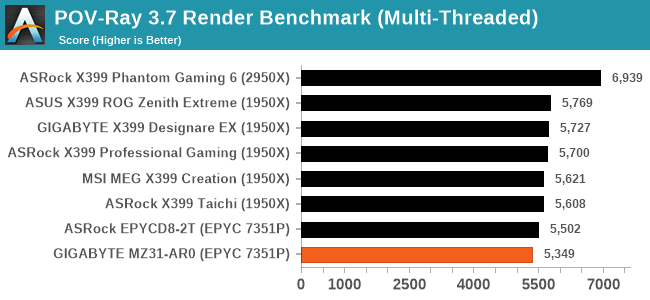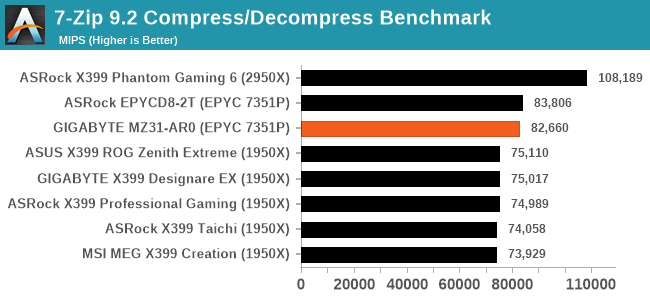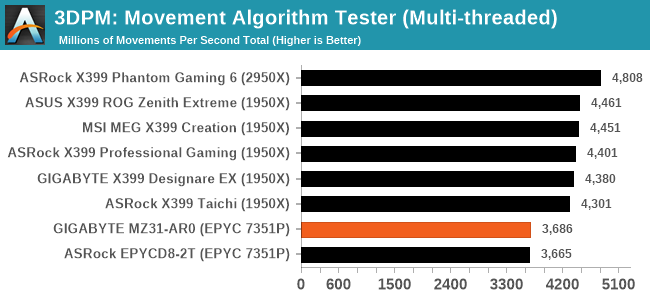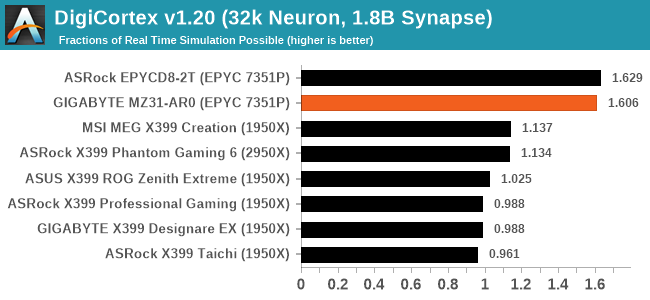The GIGABYTE MZ31-AR0 Motherboard Review: EPYC with Dual 10G
by Gavin Bonshor on March 25, 2020 1:15 PM ESTCPU Performance, Short Form
For our motherboard reviews, we use our short form testing method. These tests usually focus on if a motherboard is using MultiCore Turbo (the feature used to have maximum turbo on at all times, giving a frequency advantage), or if there are slight gains to be had from tweaking the firmware. We put the memory settings at the CPU manufacturers suggested frequency, making it very easy to see which motherboards have MCT enabled by default.
For this review we are running using Windows 10 64-bit with the 1909 update as per our Ryzen Threadripper 3960X and 3970X CPU review.
Rendering - Blender 2.7b: 3D Creation Suite - link
A high profile rendering tool, Blender is open-source allowing for massive amounts of configurability, and is used by a number of high-profile animation studios worldwide. The organization recently released a Blender benchmark package, a couple of weeks after we had narrowed our Blender test for our new suite, however their test can take over an hour. For our results, we run one of the sub-tests in that suite through the command line - a standard ‘bmw27’ scene in CPU only mode, and measure the time to complete the render.

Rendering – POV-Ray 3.7.1: Ray Tracing - link
The Persistence of Vision Ray Tracer, or POV-Ray, is a freeware package for as the name suggests, ray tracing. It is a pure renderer, rather than modeling software, but the latest beta version contains a handy benchmark for stressing all processing threads on a platform. We have been using this test in motherboard reviews to test memory stability at various CPU speeds to good effect – if it passes the test, the IMC in the CPU is stable for a given CPU speed. As a CPU test, it runs for approximately 1-2 minutes on high-end platforms.

Synthetic – 7-Zip v1805: link
Out of our compression/decompression tool tests, 7-zip is the most requested and comes with a built-in benchmark. For our test suite, we’ve pulled the latest version of the software and we run the benchmark from the command line, reporting the compression, decompression, and a combined score.
It is noted in this benchmark that the latest multi-die processors have very bi-modal performance between compression and decompression, performing well in one and badly in the other. There are also discussions around how the Windows Scheduler is implementing every thread. As we get more results, it will be interesting to see how this plays out.

Point Calculations – 3D Movement Algorithm Test: link
3DPM is a self-penned benchmark, taking basic 3D movement algorithms used in Brownian Motion simulations and testing them for speed. High floating point performance, MHz, and IPC win in the single thread version, whereas the multithread version has to handle the threads and loves more cores. For a brief explanation of the platform agnostic coding behind this benchmark, see my forum post here.

Neuron Simulation - DigiCortex v1.20: link
The newest benchmark in our suite is DigiCortex, a simulation of biologically plausible neural network circuits, and simulates activity of neurons and synapses. DigiCortex relies heavily on a mix of DRAM speed and computational throughput, indicating that systems which apply memory profiles properly should benefit and those that play fast and loose with overclocking settings might get some extra speed up. Results are taken during the steady-state period in a 32k neuron simulation and represented as a function of the ability to simulate in real time (1.000x equals real-time).











37 Comments
View All Comments
xyvyx2 - Wednesday, March 25, 2020 - link
physically the same, but not compatible :(https://en.wikipedia.org/wiki/Socket_sTRX4
Operandi - Wednesday, March 25, 2020 - link
Looks like the perfect board for my home Pfsense build. In all seriousness though looks like a pretty baller single socket Epyc board if only I had something lined up that could use it.Deicidium369 - Sunday, April 12, 2020 - link
a door stop would be an appropriate use for it - unlikely AMD would have the drivers ironed out.MenhirMike - Wednesday, March 25, 2020 - link
Does anyone know if it's possible to use Unbuffered ECC RAM with EPYC? Thinking of upgrading from a Threadripper to an EPYC for a Server, but I don't want to rebuy RAM as I already got enough DDR4 ECC UDIMMs.Slash3 - Wednesday, March 25, 2020 - link
Some Tyan boards seemingly support it from their spec sheets, but it's something that most reviews don't cover, unfortunately.Patrick at Serve the Home has also mentioned support on some older boards, but unfortunately he didn't mention any specific models in the one comment I was able to dig up on their forums.
MenhirMike - Wednesday, March 25, 2020 - link
Also, curious if the board supports bifurcation - the lack of M.2 Slots would make it perfect for e.g., an ASUS HYPER M.2 X16 or Supermicro AOC-SLG3-2M2 card, but for that it needs to support bifurcation of an x16 into 4x4 or an x8 into 2x4 slots.Slash3 - Wednesday, March 25, 2020 - link
The Hyper M.2 is long enough that you wouldn't be able to insert the card into the first five slots, which is a bit of a bummer. I can't confirm bifurcation support but I'd be very surprised if it didn't have it.phoenix_rizzen - Thursday, March 26, 2020 - link
We built our first iSCSI storage box around this motherboard. Have nothing but great experiences with it, and the IPMI implementation is light-years beyond what Supermicro supports (the GB IPMI is fully-web-enabled, using HTML5 KVM/console redirection, compared to the horrid Java implementation that Supermicro uses).The only downside if the SlimSAS connectors. It's very easy to find SlimSAS-to-SATA connectors (even comes with some in the box). Pain in the ass to find SlimSAS-to-SFF8084 connectors to connect to multi-lane, direct-attach backplanes! They exist, but nobody actually carries them (at least nobody that we could find in North America). Had to get them from a cable maker in China, which took the very slow boat to arrive.
For our first build, I messed up the model number for the backplane, ending up with an SAS expander version, so we had to use an HBA anyway.
For our second iSCSI storage server, we switched to the MZ01-CE0 motherboard. This includes 10GBase-T ports instead of SFP+. Other than that, it's virtually the same board. Got the right model backplane, and the SlimSAS-to-SFF8084 cables, giving 16 SATA connections direct off the motherboard.
For our next ZFS storage server, we'll be using MZ01-CE0 in a 2U chassis, running the OS off the motherboard connectors, with LSI/Broadcom/whoever-they-are-now HBAs with external connectors going to multiple 45-bay storage chasssis. That setup works great with all the extra PCIe lanes. :)
fazalmajid - Friday, March 27, 2020 - link
What OS do you use for your ZFS/iSCSI servers?phoenix_rizzen - Saturday, March 28, 2020 - link
FreeBSD